

No matter if you’re a seasoned trekker or just trying hiking for the first time, this guide will help you be a more sustainable hiker! There’s plenty we can do to ensure that the environment, the wildlife and the local communities are protected. Here you’ll find all the tips you need on how to choose a destination and how to behave on a trail, plus a list of all the packing essentials to make your hike epic. Happy eco-friendly hiking!
Eco-friendly hiking
Can you think of something better than hiking to switch off and find peace? You get to disconnect straying through the most beautiful surroundings while aiding physical fitness. Seriously, it’s an amazing activity!
Actually, it has been scientifically proven that hiking has measurable mental benefits and might even reduce the risk of depression. This means that both our bodies and minds gain from strolling through nature. Shouldn’t we make sure we show appreciation and respect back to the outdoors?
Hiking can be non-intrusive: we can explore deep into nature without destroying the flora nor endangering the wildlife. But there are steps to be taken. And they have to go even further than protecting the ecosystem.
Sustainable tourism is a fairly new concept, but it has rapidly gained relevance because of its importance in three different pillars: environmental, socio-cultural and economic. All activities related to traveling, including hiking, are ruled under the same parameters. This means that when we go to nature, we need to make conscious decisions to protect the environment, but also the local communities and their economies. I’ll elaborate more on the next section.
RELATED POST: The Ultimate Guide to Sustainable Travel
Leave no trace principles
The very bases for eco-friendly hiking were written by the NGO Leave No Trace. They laid a set of seven guidelines for anyone visiting the outdoors. Make sure they become your mantra!
- Plan ahead and prepare
- Travel and camp on durable surfaces
- Dispose of waste properly
- Leave what you find
- Minimize campfire impacts
- Respect wildlife
- Be considerate of other visitors
The best sustainable hiking tips
Explore locally
It’s alluring to think of exotic and far away destinations, but we often forget how amazing our own backyard can be. In most places in the world you´ll be near a national park, a natural reserve, a forest, a desert, a mountain, or a recreational area.
Don’t believe me? Platforms as All Trails, Outdoor Active and Hiking Project use interactive maps to find hikes close to you.
Looking for local places to explore also means less traveling footprint, since you’ll reduce your CO2 emissions on transportation.
Don’t go to overcrowded places (or go off season)
The classics are classics for a reason, so it’s understandable that we all want to experience them. I mean, the trek to Everest base camp and the Inca trail to Machu Pichu are part of my bucket list. But these places need to be visited off season, both to protect the environment and to support the locals to make a living all year around, not only during the high season.
If the purpose of your hike is to connect with nature without thinking of the instagrammable photo op at the end, then there’re millions of options all around the world! I’ve done spectacular hikes in the Caucasus mountains in Georgia, in the Tatra National Park in Poland, in the Dinaric Alps in Croatia, and countless treks all over my own country, Chile –where I even climbed an active volcano–, and they have been just as rewarding as other hikes to more famous places, like to the Italian Dolomites.
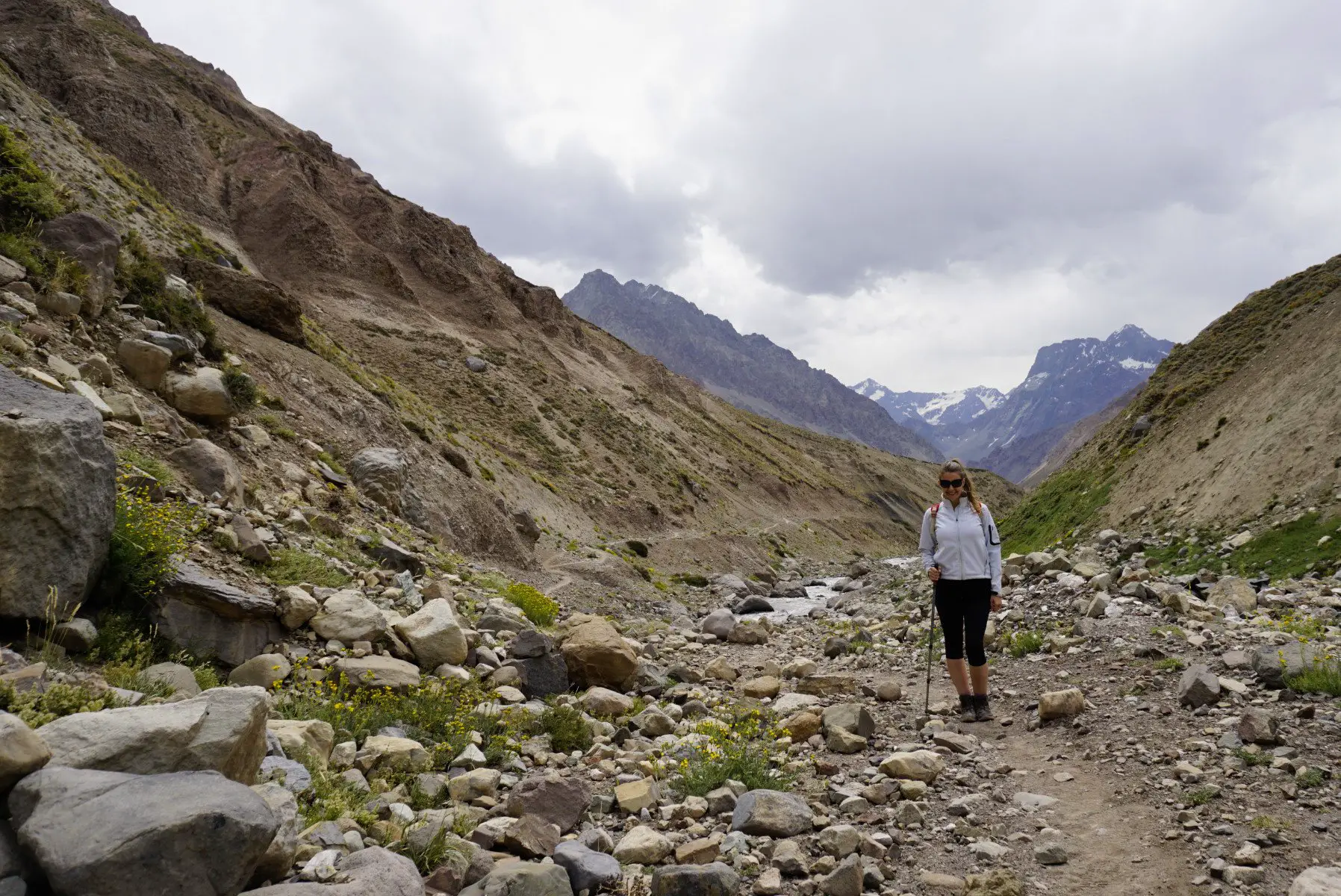
Don’t litter and pick rubbish up
This should be obvious but, judging by the amounts of trash I’ve seen in hiking trails all over the world, I think it’s important to mention it. In fact, in the United States national parks alone, over 45 million kilos (100 million pounds) of waste are generated every year.
The best you can do is to keep your rubbish with you and split it up for recycling when you return home. Whatever we bring with us, we take back with us. Even biodegradable waste like fruit peels, seeds and cores should be kept, because if you dispose of them along the trail, they can affect the natural balance of the ecosystem.
You’ll get extra eco-friendly points if you also pick some trash up while hiking. Usually I take a bag with me and on the way back I pick up as much as I can. I believe that doing what’s best for the places we visit should be a goal for every traveler, so I’m happy to do my part!
Human waste correct disposal
No one likes to talk about this, but it wouldn’t be eco-friendly hiking if we pee or poop carelessly.
For solid human waste, dig a cathole 15-20 cm (6-8 inches) deep and at least 60 meters (200 feet) away from any water sources, campsites or trails. When you finish pooping in it, cover it and place a stick or a rock on top so wild animals don’t dig it up.
As for the toilet paper, wipes, or tampons you used, they need to be packed and carry with you to be disposed in a bin –still, choose biodegradables ones. If you want to take your sustainable hiking to the next level, to avoid waste you can use an antimicrobial pee cloth (it’s a thing –I was just as surprised as you are!) and a menstrual cup.
Also follow the rule of being at least 60 meters (200 feet) away from any water sources to wash your hands, or better yet, use an eco-friendly hand sanitizer.
See my recommendation on these products in the next section: sustainable hiking packing guide.
Stick to the trails
The whole point behind sticking to the trails is to lessen the disruption of the ecosystem. Consider that opening a hiking trail already damaged the place you’re exploring, so it’s important to be eco-friendly and no harm it further. I know it’s tempting sometimes to wander off, but you can endanger the wildlife, the environment and yourself. Simply stay in them, no exceptions!
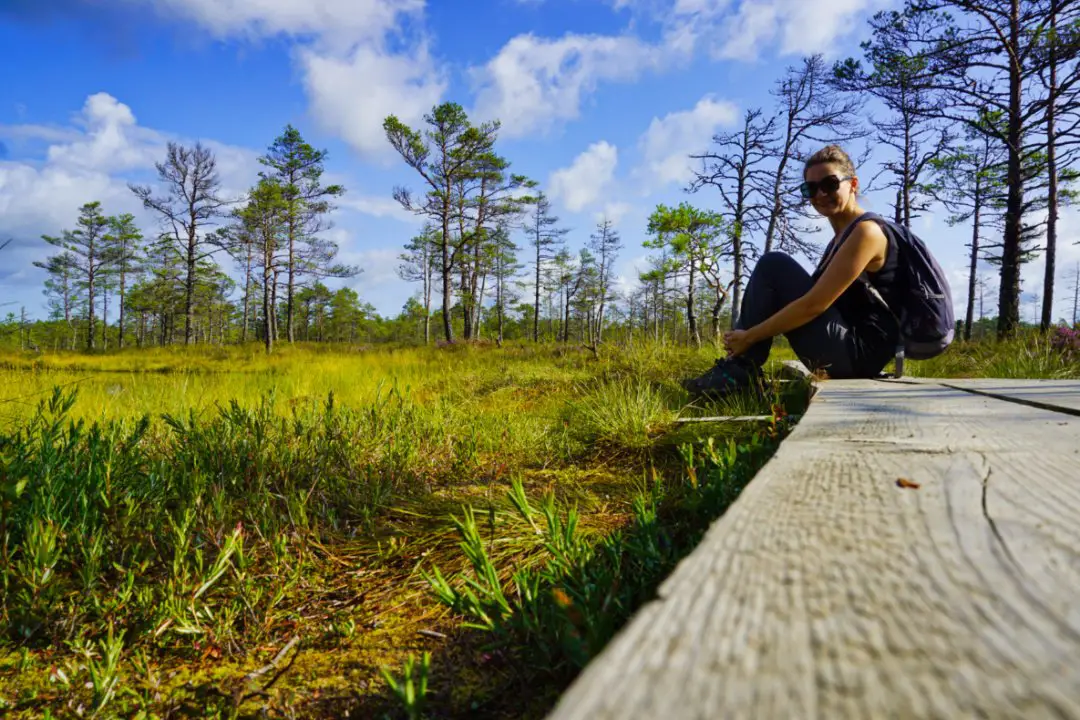
Don’t disturb the wildlife or the vegetation
Firstly, don’t take flowers, plants, rocks, earth or sand with you. Remember the mantra “leave nothing but footprints, take nothing but memories”.
As for wildlife, you must accept that animals are not entertainers and the outdoors is not a circus. Disturbing the fauna can have awful consequences. The most common practice that must be stopped is feeding the animals. Even if you think you’re helping them, if they are wild, you’re not!
Using food as bait to get them close for a photo op is the worst! The times of isolation showed us how much damage humans have made to wild animal that got used to visitors feeding them, so they don’t know how to look for food on their own anymore. See this heartbreaking video of hungry monkeys in empty Thailand to get a better grasp of the magnitude of the problem.
For wildlife photography I have a set of rules: let them come to you, don’t disturb their environment, reflect on the possible impact of your actions, and remember that you are a visitor in their land.
RELATED POST: Sustainable Travel Photography
Support local businesses
As mentioned at the beginning, sustainable hiking goes beyond being eco-friendly –it also encompasses caring about the local communities and their economy. An excellent way to do so is supporting local businesses. This means staying in locally operated lodges, looking for locally produced food in locally owned eateries, and hiring local guides.
This way you’ll be helping to fund environmental and cultural conservation, and you’ll be giving the locals an extra incentive to protect their region too, especially in places where taking care of the natural environment is not a concern.
Think carefully about fires
The number of wildfires started by humans is insane –a staggering 85-90% in the US, for example. This figure includes unattended campfires and discarded cigarettes.
So, if you are thinking of building a fire to cook, boil water or keep yourself warm, there are measures you need to take to be positive you won’t burn the place. Most public campsites and picnic zones already have fire regulations in place, so be certain you read them. And absolutely don’t do it if its prohibited.
Here are some basic rules to follow if the place doesn’t have a specific set:
- Make sure it’s not too windy
- Only collect sticks that are dead or already detached
- Dig a pit away from overhanging branches, in an open area, and create a stone ring to prevent the fire from spreading
- Don’t leave the fire unattended before it’s completely extinguished. Mind that even when it looks out, sometimes there are embers that can still be a fire hazard
- To verify it’s out, dump water on it and stir it with a shovel or a stick. If the earth is cold to the touch, it’s safe to leave.
In general, I think the risk of a wildfire is too great to take it. I rather go to a place with a designated fire zone, or use a camping stove instead. If you must light a fire, be as cautious as you possibly can!
Quick note to solo female hikers
As a (mainly) solo female traveler, I find myself alone in a hiking trail quite often. I’ve learnt that it’s important to trust my instincts. If it doesn’t feel safe, it probably isn’t. If you don’t feel comfortable going alone, find a partner until you get the hang of it. If you’re still not sure, stick to national parks, where at least there’ll be rangers in case you need help.
Also, if you can, record your entry, and always let someone know where you’ll be and when you’re expected to return. Safe is safe : )

The ultimate sustainable hiking packing guide
Backpack
The first item you need in any packing list is a backpack, right? There are so many in the market that it’s hard to choose, but I recommend taking your time with this item. If you select the right one, it can end up being a once in a lifetime purchase, which is great for both the environment and your pocket!
I have 2 favorites. One that’s big enough to be used as a carry-on for any trip, and one smaller daypack:
Osprey Fairview 40 Backpack
Beyond having all the features I look for comfort in a backpack, and the fact that it meets the carry-on size restrictions for airlines, what draws me to Osprey is their “All Mighty Guarantee”. This means that they will repair any damaged or defective bag, or replace it if it can’t be repaired. This way we use our pack for as long as possible, and when it can’t be used any longer, they take the parts to repair other bags. In practice this is like getting a zero-waste backpack. Awesome, right?
They have specific models for women and men, with specific characteristics to adapt to each anatomy. In both versions the frame suspension transfers the load from harness to hip belt, and a mesh back panel improves ventilation. Both of them also feature a large panel zip access to main compartment, dual front compression straps and mesh pockets, a heat-embossed scratch-free zippered slash pocket, and laptop and tablet sleeve secure in lockable compartment.
Lowe Alpine Aeon 27 Daypack
The Lowe Alpine Aeon 27 is an ultra-lightweight, technical daypack. It’s hydration compatible and top loading with lid and a spacious lid pocket, plus a large front stretch stash pocket and easy reach side stretch pockets, as well as internal security pocket. It also features a secure tip gripper, walking pole attachments, ice axe loops, and double side compression for stability.
The best part is that all Lowe Alpine’s fabrics are fluorocarbon-free. Fluorocarbon is what most other brands use to make materials waterproof, and to prevent dirt and oils from adhering to them. The problem with it is that it’s been proven that it can leach from materials and gradually find their way into water systems, polluting them.
All Lowe Alpine products also come with a guarantee that covers the usable lifetime of the product.
Water bottle and purifier
Depending on the length of your hike, and the availability of water sources in it, you might want to pack a simple water bottle, a hydration bladder, a water filter or water purification tablets.
If there’re plenty of drinkable water sources on the way, then a simple 1-liter (33 oz) water bottle is enough.
If the water sources are far apart, if there’s no water on the way, or if the weather is too hot, then the best option is a hydration bladder of at least 3 liters (100 oz).
If there’re water sources, but you’re not sure if the water is safe to drink, then pack a water filter or water purification tablets.
Food and containers
Consider the length of the trek while planning your meals. If it’s a day hike, a couple of sandwiches, some nuts, and a few protein bars should be enough. Keep in mind that you’ll be spending tons of energy, and most likely you’ll be quite hungry. This doesn’t mean to pack more, but to pack smartly. The more whole carbs and proteins you can have on your food, the better.
As for how to carry it, the most eco-friendly decision you can make is to do zero-waste hiking. The first step is no single-use plastic. Get a reusable meal kit, or collapsible containers plus a bamboo cutlery set, and say goodbye to unnecessary trash.
Optional: as we discussed before, if you want to boil water or cook during your hike, to reduce the risk of a wildfire, carry a lightweight and compact camping stove with you. There are options (like this one) that include a couple of pots in its all-in-one package. Don’t forget the fuel canister.
RELATED POST: Vegan travel, Sustainability and the most veg-friendly destinations
Hygiene items
We talked about disposal of human waste in the previous section. To make sure you do it sustainably, add biodegradable toilet tissue rolls or biodegradable wet wipes, a lightweight aluminum shovel and an eco-friendly hand sanitizer to your hiking packing list.
There’s also the option of anti-microbial pee cloths. One side is absorbent while the other side is waterproof. After using it you fold it in half and close it with a snap to keep the dirty side from touching anything else, then clip it to the outside of your pack to let it dry out in the sun. Sounds odd, but it’s easier than carrying dirty toilet paper!
Women should also consider a menstrual cup or reusable sanitary pads –not only while hiking, it’s the eco-friendly thing to do all the time!
Sunscreen and bug repellent
The products we use on ourselves also can have an impact on the environment. If you´re planning on jumping on a lake, river, waterfall or any water source, then you should choose a paraben, octinoxate and oxybenzone free sunscreen. That means no chemicals that can hurt the environment.
Same goes for bug spray. Mosquitoes and other bugs can be relentless, so we need to keep them away, but without harming them. After all, we’re entering their territory! Choose a bug repellent made of natural ingredients and no chemicals.
If you’re more old-fashioned, a compass and a trail map will be your companions. Now, if you prefer to rely on technology, get a GPS device. I find a multisport GPS smart watch to be an amazing investment. Not only it’ll help you with data of your whereabouts, it’ll also track your fitness progress and it’ll record the info of your hike. It’s a pretty cool gadget!
First-aid and survival kit
I always say this, but it’s true: nothing happens until it happens –so when it does, you better be prepared. We always think that bad things don’t occur to us, but, unfortunately, sometimes they do. This is not exactly about being eco-friendly, but as carrying a few things in the bottom of your backpack can literally save your life, it’s worth to put these items on your hiking packing list:
- A small first-aid kit
- A headlamp
- A survival kit or a paracord bracelet and a multitool
- An emergency blanket
Clothes
Hiking shoes and socks
The main characteristic of your hiking shoes is that they need to be comfortable and have a good grip. To be sure they’re sustainable they need to be labeled as vegan. Some brands could also say non-leather, synthetic or organic. Merrell and La Sportiva, for example, have a whole line of sturdy vegan hiking shoes. For winter, these ones are great, while I recommend these ones for summer.
Darn Tough makes socks with great performance. They’re made of Merino Wool, an ideal material for breathability and comfort in all conditions. Their socks also repel bacteria and odor, and they’re guaranteed for life.
Tops and jacket
What to choose here will depend on the time of year, and the weather expected during your hike.
For hot environments, choose a quick dry t-shirt with UV protection –make it long-sleeved if the sun is too strong. Also pack a lightweight fleece or a softshell jacket because the temperatures can always drop or wind can pick up unexpectedly.
For cold conditions, you’ll need layers. A base layer with the ability to wick sweat from your skin, a middle layer for insulation (like a fleece or a sweater), and an outer layer to shield you from the wind and rain. For base and middle layers, you can find cheap yet technical options in stores like Decathlon. As for the outer layer, is worth it to invest in a sturdy jacket –the North Face Thermoball Eco Triclimate is an excellent sustainable choice.
Pants
Same as with tops, it’ll depend on the whether conditions. For summer, even though shorts are the preferred choice of most, I tend to stick to long hiking pants with UV protection to shield my legs from long exposure to the sun, from branches, and from insects. A great middle ground are convertible pants, where you can detach the bottom part to make them shorts.
For winter, you’ll need a bottom first layer to wick sweat from your skin, and waterproof, breathable hiking pants, that will work as both insulating and outer layer.
Hat and sunglasses
You’ll need either a sun hat or a warm beanie. In any case make sure it’s a breathable and made of a quick dry fabric. Sunglasses are always a must.
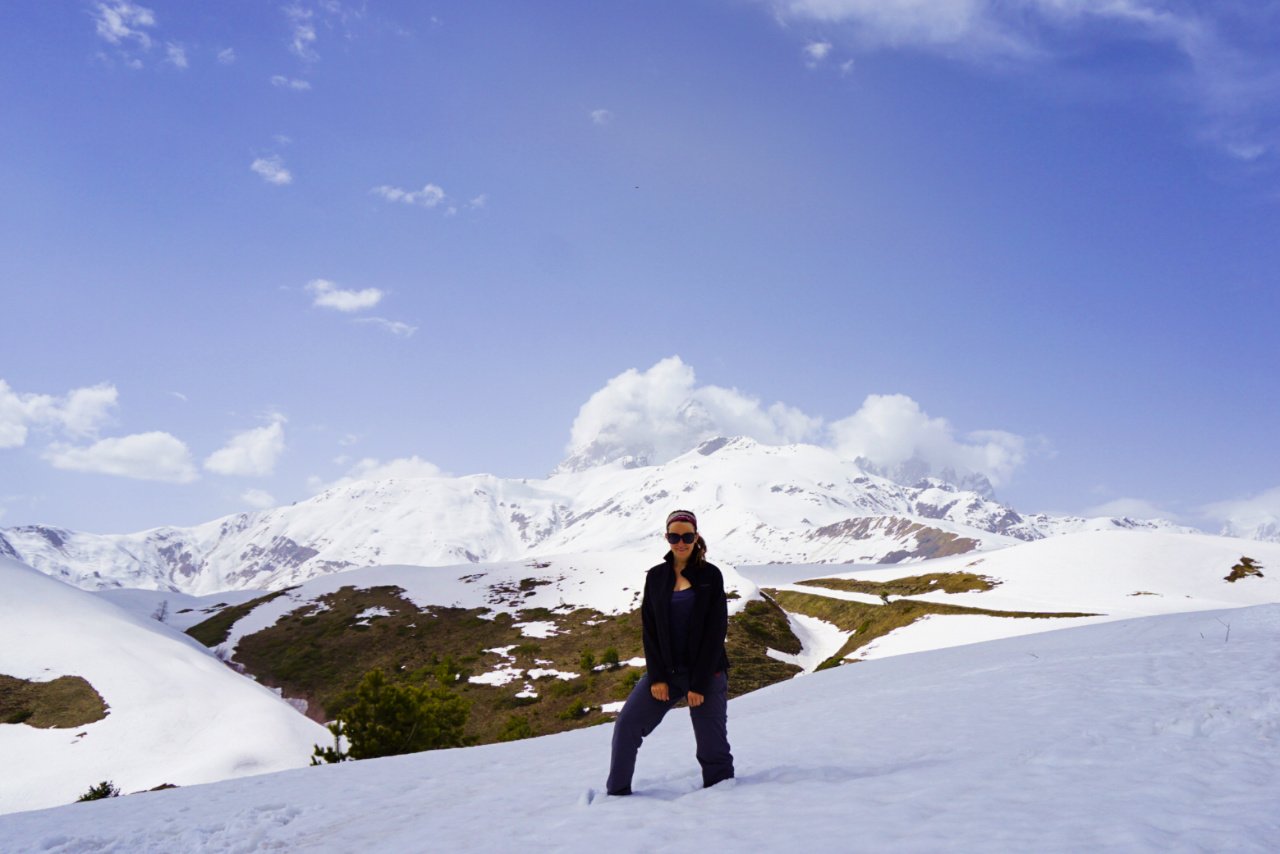
You’re all set to hit the trails as a sustainable hiker!
Do you have any questions on eco-friendly hiking? Ask me in the comments : )
RELATED POSTS:
- The Ultimate Guide to Sustainable Travel
- Sustainable Travel Photography
- Vegan travel: Sustainability and the most veg friendly destinations
- Travel resources: the best travel tips and tricks
- The ULTIMATE Travel Experiences Bucket List
Liked it? Want to read it later? Pin it!
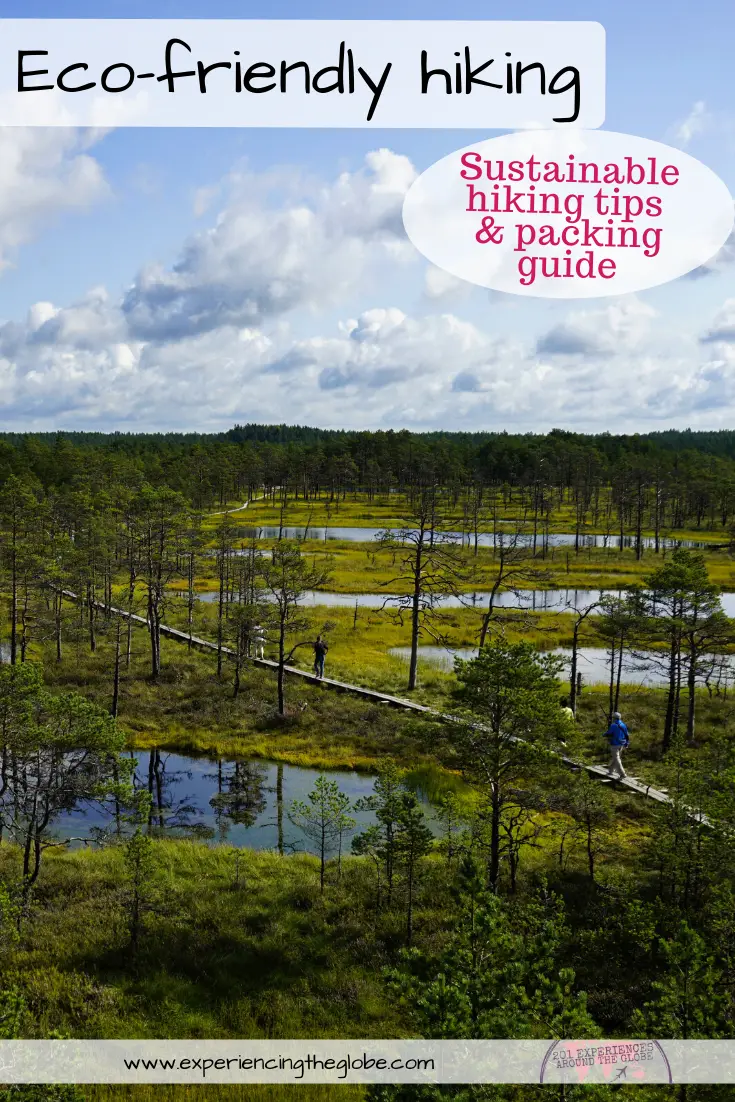
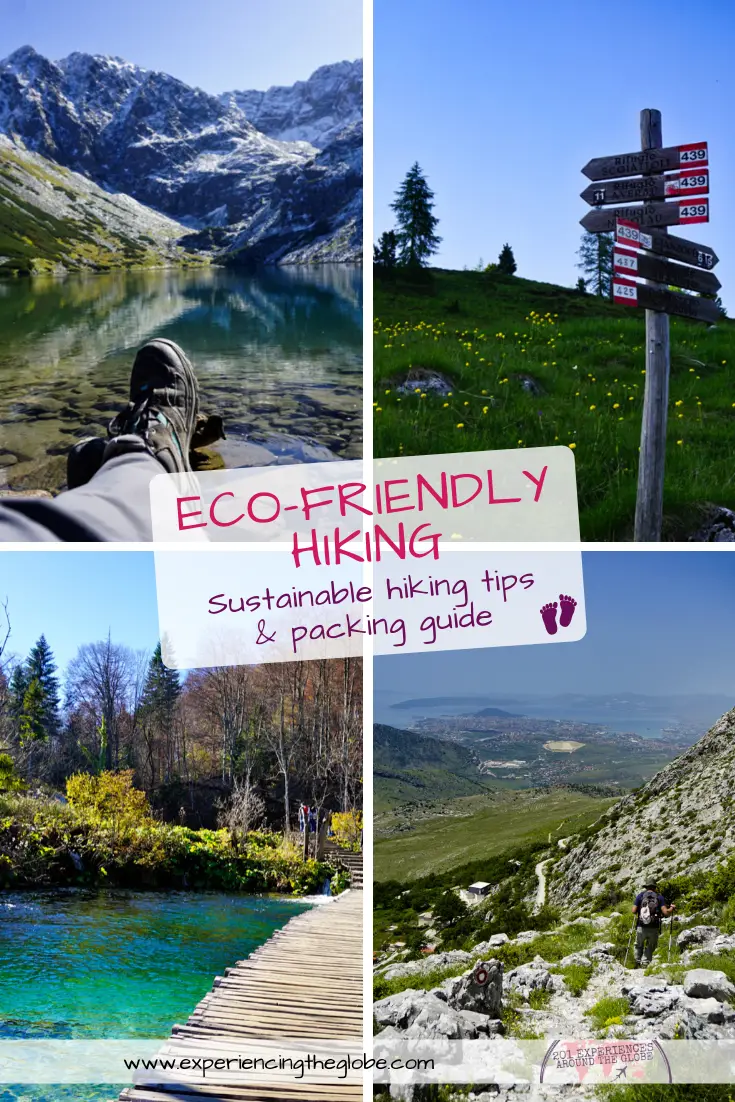
Enjoyed what you read? A lovely way to show your appreciation is by buying me a cup of coffee 🙂
Your support will ensure I keep bringing you stories and insights from around the world! Thanks so much!



Such a great guide for eco-friendly hiking. Here in Bavaria during the lockdown people flocked to the mountains and the increase in trash and trail damage is stark. So, it’s always a great reminder to get off the beaten trail, avoid crowds, explore locally, and to pick up trash. I’ll add a reminder to look up any local guidelines. Here in Germany, for example, we have certain areas that are off-limits at certain times for a year to help vulnerable plants and species survive, so it’s important to know the trail signs Thanks so much for sharing.
That’s so important! Following any local guidelines should be the first thing to do, even though, sadly, a lot of people feel like they know better. I hope that because of the pandemic we all realize how particularly relevant is to be sustainable 🙂
What a fabulous post. I appreciated your description of principles and rules to live by, and links to specific products. Your reference to Osprey’s guarantee resonated with me. My Farpoint 40 suffered a nasty case of road rash and it was replaced free of charge. There were plenty of reusable pieces left on my damaged pack and it was reassuring to think they would be used to repair other packs. Thank you for sharing your insights.
Thank you, Anne! I’m glad you enjoyed the read, and it’s great to hear some first-hand experience about Osprey’s guarantee, since I haven’t had to use it 🙂
These are all great tips! I really don’t like to see garbage on the ground when I’m hiking, I don’t understand why people don’t take it away with them and throw it out properly!
I can’t understand it either, but I think more and more people are getting the importance of sustainability nowadays -and I’m here to spread the word for those who still don’t 🙂
This is such great information! We love being outdoors and are trying our best to make the right choices. I especially hate seeing people leave garbage all over trails. And I didn’t consider going in off season as a sustainable way before. Thanks for opening my eyes to these new ideas!
I’m so glad to help out in your sustainable journey, Deb. Thanks for letting me know! 🙂
Excellent suggestions and a very thoroughly researched post! I appreciate your focus on eco-friendly ways to deal with human waste since it isn’t talked about as much as it needs to be and has a big impact on local ecosystems and the enjoyment of other hikers. I also enjoyed seeing you hikes from around the world– beautiful!
Thank you so much, Erica! Hiking in different places has been amazing, but sharing what I’ve learnt is even more rewarding, knowing it can actually make a difference for the destinations 🙂
I’ve been thinking about what to do to take better care of the places I visit, since I’m a new hiker. This post was exactly what I needed. Thanks for sharing.
I’m so glad to hear this, Daniel! Enjoy being a sustainable hiker 🙂
I good insight and professionally written piece on how to be “green” when hiking. I enjoy backpacking the world and hiking is one of my favourite activities to enjoy. A lot of these tips I have tried to implement, but I really like the point you made about avoiding crowded places when hiking and going in the off season. I never would of thought this would be sustainable, so thank you for opening my eyes with this tip- I will consider this on my next trip.
I’m so happy to help, Joe! I’m sure you’ll enjoy your next hiking trip even more if you go off season, and it’ll feel even better to be more sustainable 🙂
Love these easy and practical tips on sustainable hiking…lots of eco-friendly reminders about our behaviors when appreciating nature.
Being sustainable is easier than we tend to think, it’s mostly a matter of knowledge. Now you have it, so happy eco-friendly hiking!
What a great post! What really resonated with me is the point about exploring our own backyard- I’ve only recently started doing this (kind of forced to!) because of Covid, and I’ve found some really neat places around me. I also agree with finding places that aren’t overly crowded and sticking to trails (but I’d hate to step on something or get caught on some type of plant, haha!). We also love to support small business – even more now during this whole pandemic. Can’t wait to get out and explore some more!
There’s always so much around us that we take for granted. This has been a (forced, but still) great opportunity to discover and appreciate it. And helping out your own local community makes it even better!
These are some really great tips, Coni! My husband gave me an Osprey Fairview 40 backpack a few months ago, and I love it. Good recommendation. I hope it does last me a lifetime.
Thanks so much! And great present -I’m sure you’ll enjoy it in many many trips!
Some awesome trips to do our part in protecting the planet! Thanks for sharing 🙂
Happy to help spreading the word!
These are all really great tips! I like trying to visit off-season whenever possible and I’ve been trying to carry a trash bag with me so I can clean up trails whenever I go hiking. Absolutely agreed on menstrual cups/reusable sanitary pads–it saves on so much waste!!
Thank you, Farrah! It’s great to see that hikers that already do their part keep looking for advice on how to do even better ❤️
Fantastic tips for eco-friendly hiking! I recently invested in a Grayl water bottle purifier, and it’s been amazing. Being able to just scoop up river or lake water to drink while out in the wilderness is so convenient.
Thanks, Erin! A purifier is a great investment! I take my LifeStraw everywhere, even to city escapes if the water there is not drinkable. It’s a life-changer, and definitely the sustainable choice. I loved to say bye to plastic!
I’ve been looking for a good hiking backpack! I’ve heard a few whispers about Osprey so I’m reassured seeing them here! I’ll have to go in for a backpack fitting though!
The Osprey one is always my overall choice. It’s great to travel, and big enough for everything you might need in a hike. Now, if you will mostly do day hikes, the Lowe Alpine is better, since it’s smaller and lighter. But you can’t go wrong with any you choose 🙂
I’m so glad I came across this guide! I am leaving for a short hike over the weekend and these tips are definitely going to help me then.
I’m so glad, Merryl! Happy (and sustainable) hiking!
These are such great tips! Hiking is such an eco-friendly activity when done properly so it bugs me when people aren’t considerate and leave garbage behind or disturb the environment. Thanks for the recommendations for products as well 🙂
Thanks, Kelly! I completely agree. It should be a given to be sustainable when you explore nature, sadly it’s not. But the good news is that more and more people are starting to be conscious of the consequences of their actions, and improving. I think this guide should help! 🙂
Hola Coni!!
What a great post! I am just coming back from a few days hike around the Chauki Mountains in Georgia ( I saw your photo from Mestia!!) I really appreciate your article so complete and so important to share! I will save your blog to share it in my next article about slow travelling! Looking forward reading you more! xoxox
Thanks so much! I’m happy to hear how much you enjoyed the read! ❤️
So cool you were in Chaukhi! I only made it to Stepantsminda (and the Gergeti Trinity church), but I’d love to go back to hike more around the area. Some day!
Great post! I’d love to emphasise “don’t litter and pick up rubbish”. The amount of garbage we find along hiking trails is pretty sad, so it’s always a good idea to bring a bag with you to collect what you can while you’re out and about.
Thank you, Katherine! It is indeed sad to see how some people are looking to connect with nature, yet they’re so disrespectful with it. Hope the ‘pick rubbish up’ thing becomes a trend! I do it in trails and beaches, and it’s really satisfying to give back to the places that give me so much ❤️